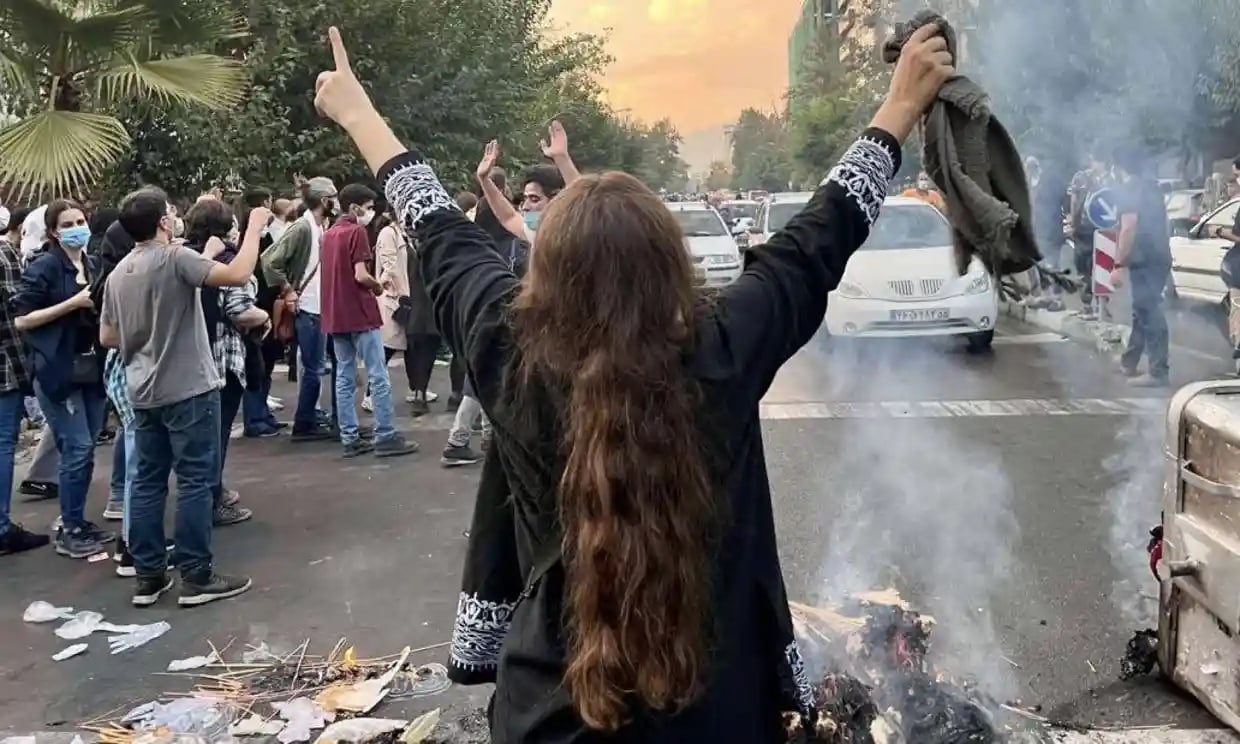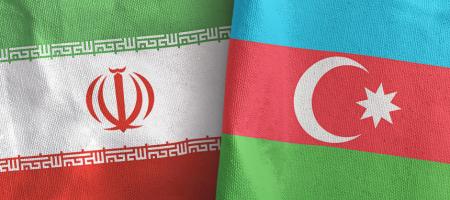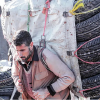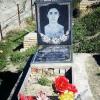
By: Elham Assadzadeh
The early days and weeks of the protests in Iran, the primary objective of the slogan, “Woman, Life, Freedom”, seemed to be a demand for justice, equality and an end to gender apartheid, inspired by its Kurdish roots. Women and girls then started to remove their headscarves in public to show their objection to compulsory hijab. However, as the protest narratives continued across the nation and the globe and were met by the brutal crackdown of Iran’s government on protesters, the protests took a different direction, targeting the Supreme Leader Ali Khamenei, and the whole regime, all the while chanting “Woman, Life, Freedom” as the rallying cry of the movement, with just a different purpose. The people in Iran and the diaspora chanting “Woman, Life, Freedom” want nothing but an end to this dictatorship regime ruling Iran.
The people in Iran, the women and girls, currently fighting in the streets, are not risking their lives anymore in hopes of just removing their headscarves or having equal place with men; they are fighting tooth and nail and risking their lives for what they see as the most foundational objective of “Woman, Life, Freedom”.
As a result of the regime’s 43 years of suppressive ruling and its recent brutal crackdown on the peaceful protests, the Iranian people have understood that the philosophical meaning of “Woman, Life, Freedom”, can no longer be accomplished, while this regime is in power.
The evolving objective of the slogan, “Woman, Life, Freedom” is not a rational or logic argument, it is a narrative paradigm that helps us understand this complex shift of objective through the ongoing narratives of these protests.
The objective of a slogan can also change from one demonstration to the next, depending on the evolution of the demands, the counterattacks of the government in power and even how far it becomes national and international.
On September 13, 22-year-old Kurdish Iranian woman, Mahsa (Zhina) Amini, was arrested in Tehran by the so called “morality police” for “improper veiling” under the Islamic Republic’s strict dress code. The family, from Saqqez, had been in the capital on a holiday. While in custody, Amini was severely beaten and went to comma. She died three days later.
Amini’s death sparked a wave of unprecedented protests that quickly spread across the country and the world. Mourners first chanted “Jin, Jiyan, Azadi” (Woman, Life, Freedom) at her funeral in her hometown of Saqqez. The slogan quickly spread from the country's Kurdish cities to the capital, Tehran. It then took on a new life in its Farsi translation, "Zan, Zendegi, Azadi". Following the expansion of Iranian protests around the globe, the slogan, “Woman, Life, Freedom”, became the battle cry of the movement against the Iranian regime.
The regime responded with a systematic violent crackdown against the protesters, killing hundreds and arresting thousands of civilians, journalists, activists and even children.
The slogan, “Woman, Life, Freedom”, is a popular political Kurdish slogan that dates back to the 2000s, where it was first used by members of the Kurdish women’s movement, the BDP (Peace and Democracy Party), a predominantly Kurdish political group historically linked to the PKK (Kurdistan Workers’ Party), in response to persecution from the governments of Iran, Iraq, Turkey, and Syria. The slogan was first popularized during International Women’s Day marches across Turkey in 2006. It then became popular around the globe such that on 25 November 2015, it was used in gatherings held on the occasions of the International Day for the Elimination of Violence against Women in several European countries.
The slogan is considered attractive because of its spelling, rhythm and connotational significance. “jin, jiyan, azadi” (Woman, Life, Freedom) in Kurdish, speaks to radical commitment to women’s liberation (“jin”), ecology (“jiyan”), and against state oppression (“azadî”).
Four months into the Iran protests, the rallying cry is “Woman, Life, Freedom” inside and in the diaspora and there are no signs of abating.
The events unfold following Amini’s death on September 16. The slogan, “Woman, Life, Freedom” was first chanted by mourners in Kurdish, “Jin, Jiyan, Azadi”, at her funeral in her hometown of Saqqez, followed by people of Sanandaj in protest to her brutal death. Mourners took off their headscarves in defiance of what Amini was accused of. Kurdish people in Iran are among the ethnic minorities most oppressed by the regime ruling Iran. With its roots to the Kurdish women’s movement, “Jin, Jiyan, Azadi”, speaks to the idea that a country cannot be free until its women are free, demanding justice for Amini, equality for women and end to gender apartheid.
https://twitter.com/FSeifikaran/status/1571023553956552706?s=20&t=PC6O3UzKgr3YNisWRdOmBQ
On September 18, demonstrations spread to the capital, where hundreds gathered around the University of Tehran, chanting “Woman, Life, Freedom” in Farsi (Zan, Zendegi, Azadi).
https://twitter.com/AlinejadMasih/status/1571431245921361920?s=20&t=kdMP3nYEPlg922HJ7ke79w
Soon after, people in other major cities like Isfahan, Rasht, Shiraz and Mashhad joined the protests. The demand of the protesters was justice for women and an end to wearing forceful hijab. Girls and women started taking off their headscarves and burning them in public.
Many describe the compulsory hijab as the Berlin Wall. The hijab is the tool of its religious dictatorship. If this tool is taken, the pillars of the regime will collapse, and it will no longer exist.
In response to the widespread protests, the regime restricted access to the internet and brutally clashed with demonstrators, arresting and killing with live ammunition. Despite the crackdown, protesters continued chanting “Woman, Life, Freedom”.
On September 20, 23 and 24, Sarina Esmailzadeh, 16, Nika Shakarami, 16 and Hadis Najafi, 22, were killed respectively by the regime’s security forces during the protests.
In objection to the killing of these young girls and many others, protests continued across the country and teenage schoolgirls also joined in multiple cities, removing their headscarves and chanting “Woman, Life, Freedom”. Iranians in the diaspora also held protests and gatherings in solidarity with the brave protesters in Iran, in different cities around the world.
On September 27, an Iranian singer, Shervin Hajipour, produced and sang a song called “Baraye”, which was inspired by different comments on a Twitter campaign in solidarity with the protesters in Iran, ending with the slogan, “Woman, Life, Freedom”. Hajipour was arrested on September 29, in Tehran after his song went viral and gained over 40 million Instagram views in a single day. The song, “Baraye” later became the anthem of the protests in Iran and around the globe.
https://www.youtube.com/watch?v=z8xXiqyfBg0
As the narrative of the events are unfolding, the protests across the country soon gained a momentum against the regime, chanting anti-government slogans such as “down with dictator” and “down with Khamenei”. While “Woman, Life, Freedom”, remains the main slogan of the movement, the purpose is shifting towards the roots of the problem, the Supreme Leader and regime in power. In response, the regime brutally clashed with different sectors of the society on several occasions.
On September 30, in one of the most violent clashes against another ethnic minority, the Balochis, the regime’s security forces fired on civilians during a Friday prayer in the city of Zahedan, in Southeast Iran. According to local human rights groups, the security forces killed more than 90 people, including children.
On October 2, the security forces sieged students on the campus of Sharif University of Technology – which is equivalent to Harvard University and MIT in the US – opening fire and arresting dozens. Other universities and high school students across the country joined the protests in solidarity with Sharif University students and the widespread protests.
On October 1, worldwide protests were held in solidarity with the uprising in Iran. Under the slogan, “Woman, Life, Freedom”, demonstrations took place in many major cities including, London, Melbourne, Sydney, New York, Los Angeles, Washington D.C., Paris, Toronto, Ottawa, Montreal, Rome, Seoul, Stockholm and Zurich. In Richmond Hill near Toronto, over 50,000 people attended the solidarity protests.
On October 3, the Supreme Leader Ali Khamenei, spoke out for the first time since the outbreak of the protests condemning the widespread protests as “riots” and blaming the US and Israel for planning and promoting it. He also said, with some small punishment for those “creating corruption and damaging the streets”, everything will be fixed.
On October 10, more than 1,000 oil workers, one of the most critical sectors of the economy, went on strike and chanted “death to the dictator”.
With all the sectors of the society from ethnic minorities, university students, teenage schoolgirls, to oil workers uniting across the country chanting “Woman, Life, Freedom”, “we want regime change” and “death to Khamenei”, Khamenei spoke again on state TV on October 14 and said that “no one should dare think they can uproot it” (the regime), giving one of the toughest warnings to the protesters.
On October 15, Ward 7 and 8 of Evin Prison, where the arrestees of the recent protests were imprisoned, was set on fire. Gunshots, sirens and anti-government chanting could be heard in the background with families of prisoners gathering in front of the main gate. Eyewitnesses said that when the prisoners were trying to flee the scene, the guards opened fire on them from top of the hill. The notorious Evin Prison is where many political prisoners, protesters and journalists are detained.
Despite the brutal crackdown of the regime, widespread protests continued into its second month and people were more inclined to continue until their objective is met, which is regime change. Fearing their survival, the Islamic Republic called-in forces from the Lebanese Hezbollah and Iraqi Hashd al-Shaabi mercenaries to assist in the crackdown.
On October 22, more than 80,000 people marched in Berlin in solidarity with the Iranian movement and thousands marched in Los Angeles, Washington D.C., London, Paris, Tokyo, Sydney, Istanbul and cities across Europe, chanting “Woman, Life, Freedom” and “death to the dictator”.
From October 26 onwards, the 40th day since Amini and other protesters’ died, which traditionally marks the end of mourning in Iran, began with thousands participating to commemorate despite warning by the security forces not to hold the ceremonies. These mourning ceremonies turned into large demonstrations chanting “Woman, Life, Freedom” and anti-government slogans. According to eyewitnesses, security forces shot teargas and opened fire on the protesters.
On November 13, Iran’s courts passed down the first known death sentence related to the protesters and a group of 227 parliament members in Iran called on the Judiciary to issue death sentences for people arrested during the ongoing anti-government protests. Reports indicate that more than 18,000 people have been arrested during the recent protests.
On November 15, strikes had been held in several cities across the country to commemorate the 2019 protests, which resulted in one of the bloodiest crackdowns in the history of the Islamic Republic, according to Reuters. Isfahan Steel Company, one of the largest steel producers, joined the strike, as did the shops located in the Tehran Grand Bazaar.
On November 18, through the following days, the Iranian security forces, including the IRGC (Iran’s Revolutionary Guards Corps), harshly attacked Kurdish cities including Mahabad, Bukan and Sanandaj with helicopters and heavy military presence. They shut down the power and internet and constantly fired at protesters and raided private homes. Despite the intense situations, protests continued across the country in support of the people of Mahabad.
On December 5, 6, and 7, a nationwide strike was called and businesses, traditional bazaars, medical facilities, supermarkets, truck drivers and more from 50 cities across Iran closed down and joined one of the largest strikes in decades, calling for an end to the Islamic Republic ruling Iran.
On December 8, the Iranian regime carried out the first known execution related to the anti-government protests. 23-year-old Mohsen Shekari was accused of blocking a street and wounding an officer during the protests.
On December 12, the second execution was carried out. Majidreza Rahnavard, 23, was hanged from a crane in public to create fear among protesters.
On December 16, hundreds of protesters marched in Zahedan, Sistan-Balouchestan province, chanting “death to the dictator”.
Academy Awards winning actress, Taraneh Alidoosti was arrested a week after she condemned the execution of Mohsen Shekari, the first known execution related to the protests with an image of herself without the Islamic hijab, on her Instagram post.
And as recent as December 19, 20 and 21, widespread protests and strikes were held across the country.
Despite the oppression, the protests and strikes are still continuing, with the slogan “Woman, Life, Freedom” as the battle cry of the movement and with a loud and clear message that the Mullahs regime, must go!
For the first time in the history of Iran, since the Islamic Republic came into power, Iranians inside and outside Iran, women, men, urban, rural, rich, poor, students, laborers, Kurds, Balochis and other ethnicities in Iran; celebrities, prominent figures, politicians, artists, singers and governments across the world, have all become united around one slogan, “Woman, Life, Freedom” and a singular cause for freedom.
The slogan has crossed all borders, ethnicities, religions, genders, and is being used in hashtags, speeches and in all kinds of languages around the world, causing universal support for this movement and changes in diplomacy towards the Iranian regime.
Like never before, Iranians in the diaspora have become united over one cause. For years, different Iranian dissident groups would hold their own events and rallies, but now all have come to participate in one rally, every week, in major cities across the world to be the voice of the brave protesters in Iran.
For the first time in the 43 years history of the Islamic Republic ruling Iran, with a majority of votes, the UN Human Rights Council created a fact-finding mission to investigate the deadly violence against the protesters in Iran.
And now a vote will be casted to expel the Islamic Republic of Iran from the UN Commission on the Status of Women, after women leaders from over 14 countries, including Secretary Hillary Clinton, First lady Michelle Obama, Canada’s Deputy PM Chrystia Freeland and Nobel laureates Malala Yousafzai and Nadia Murad signed an open letter published in the New York Times, calling for the UN Member States to take immediate action.
Canada’s Prime Minister, Justin Trudeau, announced that Canada will take stronger actions against the Iranian regime, including listing the IRGC and more than 10,000 officers and senior members of the regime on the list of terrorist organizations; this is while, Canada was a go to place and a haven for the Iranian government officials. He also attended the Iranian rally in Ottawa, declaring his support for the people of Iran and promising to hold the Iranian regime accountable for its crimes against humanity.
On Girl’s International Day, prominent democratic figures, First lady Jill Biden, former President and First lady, Mr. and Mrs. Obama, and Oprah Winfrey, announced their support and solidarity with the brave women and girls in Iran, who are risking their lives for freedom, on their Twitter and Instagram accounts.
In response to the brutal crackdown on the ongoing protests, Germany suspended its business with Iran, affecting its export credits and investment guarantees.
Prominent and popular American Comedian and TV host, Ellen DeGeneres, gave her Instagram account to an Iranian American activist in Los Angeles to admin the account on October 1st, The Global Day of Action for Iran, to post and share stories at the rally held in Los Angeles to bring awareness to what is going on in Iran and what people can do to help.
As a result, despite the bloody brutality of the Iranian regime towards the protesters and even children, they have not managed to stifle the movement completely and we witness the movement growing larger and stronger than ever before in the hope of toppling this dictatorship regime.
Elham Assadzadeh is an Iranian American activist and a Communications specialist residing in Virginia. @Ellie_Assad










